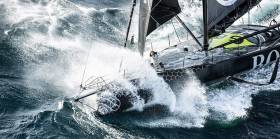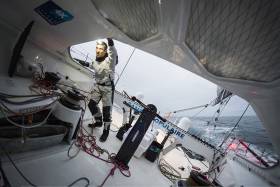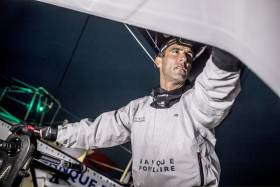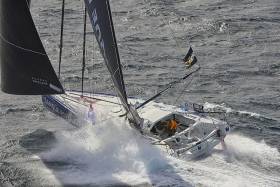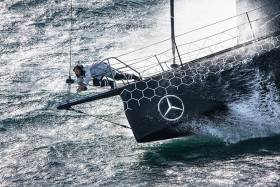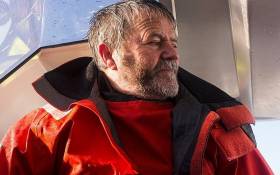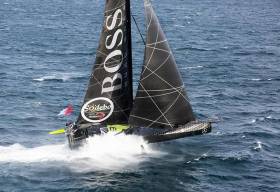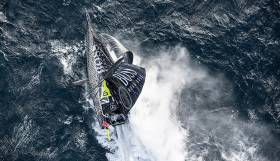Displaying items by tag: Vendee Globe
Irish Influence Remains In Vendée Globe’s Final Hours
#VendéeGlobe - Despite Enda O’Coineen’s New Year mishap taking him out of contention, the battle for victory in the Vendée Globe retains a distinct Irish flavour.
Although he conceded yesterday that his chances of victory were slim – confirmed by the latest race update — Alex Thomson is still in hot pursuit of race leader Armel Le Cléac'h and Banque Populaire to clinch second place on the home stretch to Les Sables.
The route took Thomson’s record-smashing HUGO BOSS and the rest of the fleet just hours south of Cork Harbour, where the British skipper spent many formative years affirming a love of sailing that’s taken him to the peak of the sport.
His team boss at Alex Thomson Racing, Stewart Hosford, is also based in Cork, as previously reported on Afloat.ie.
“In the year that saw Ireland win an Olympic medal for sailing, and the first Irish entry to the Vendée Globe, it would be wonderful to see the team led by an Irishman win the globe’s most challenging race”, said Hosford earlier this week.
Other Irish connections were present earlier in the race, in the form of French yacht SMA — whose team director is a Corkonian, Marcus Hutchison – and the Japanese entry Spirit of Yukoh, managed by Dublin-born Tony O'Connor.
And while both boats have since retired, their contention remains a good omen for Ireland’s place in global sailing — and might influence greater Irish participation in the next Vendeé Globe in 2020.
Vendée Globe leader Armel Le Cléac'h is expected to cross the finish line at approximately 1530hrs UTC today after 74 days at sea.
The French skipper is currently 36 nautical miles from the finish line in Les Sables d'Olonne, France, travelling at just over 12 knots.
The race finish will be streamed live on the race website and on social media once Le Cléac'h is within 30 minutes of the finish line.
Second-placed Alex Thomson is expected to cross the finish line around 12 hours later.
Vendee Globe Victory 24 Hours From Le Cléac'h's Grasp
British sailor Alex Thomson – with Cork Harbour connections – today conceded that his chances of overhauling Vendée Globe leader Armel Le Cléac'h on the home strait of the Vendee Globe were slim, despite narrowing the gap to just 35 miles. In the last 24 hours Thomson, 42, has halved Le Cléach's lead of 70 miles but as the pair prepared to enter the final 300 miles of the solo round the world race this afternoon he said the advantage was now firmly with his French rival.
Thomson revealed that for several days now he has been battling problems with the wind instruments on his cutting-edge 60ft race boat Hugo Boss, which in turn have prevented the yacht's autopilot from working properly. In spite of knocking miles off Le Cléac'h's lead overnight he said he had not slept for two days and was now dangerously tired. Speaking to the Vendée Live show today Thomson said his thoughts were on getting Hugo Boss' anemometers working again rather than the impending finish in Les Sables d'Olonne, France. "I don't think I can catch Armel," he said. "The routing is very clear – we will go nearly to the Scilly Isles, wait for a left shift and when it comes we tack. There are no real options for me any more, I think my options have run out. It might be possible to catch a few miles but it's difficult for me at the moment. Until I can get my autopilot driving on a wind angle it'll be very tricky in the conditions I have. I can't imagine another few days like the last couple of days. I don't have any tension about the finish. I have tension about trying to make the autopilots work. I've got an anemometer in my hand and I'm trying to splice wires. I don't care about the finish right now, I just want to sleep.”
Le Cléac'h, runner-up in the past two editions of the Vendée Globe, might now be odds-on favourite to claim his first race win but he was not taking anything for granted as he prepared to tack and head down the west coast of France to Les Sables. The race mantra of 'to finish first, first you have to finish' will be ringing in his ears as he sails into his final night at sea in 74 days. “For the moment I'm holding my own against Alex,” the 39-year-old Breton said, “but the final 24 hours are going to be complicated. I'm going to have to be careful as there are a lot of dangers - we have been seeing fishermen and cargo vessels since yesterday. I'll be passing the tip of Brittany tonight, then going along the south coast of Brittany. I have to remain cautious to avoid doing anything stupid.” Le Cléac'h is expected to cross the finish line between 1300 and 1900 UTC tomorrow, barring any mishaps, with Thomson following suit around four hours later.
The race tracker will update hourly once the leader gets to within 100 miles of the finish, and live streaming will begin 30 minutes from the line. For more information on how to follow the arrivals click here
Third-placed Jérémie Beyou said his routing software has calculated that he should arrive in Les Sables on Sunday evening, around three days behind the leaders. “Over the past few days I have been faster than expected,” said Beyou, whose podium position is secure for now with fourth-placed Jean-Pierre Dick trailing him by more than 1,000 miles. “The seas are not as cross and are more manageable. I'm trying not to think of the finish, as I still have the Bay of Biscay to deal with, and it's not looking very cooperative, as there won't be much wind, so I won't be advancing very quickly.” Seventh-placed Louis Burton will be the next skipper to cross into the northern hemisphere. At the 1400 UTC position update he was just 20 miles south of the Equator.
Photo–Finish for Vendée Globe Predicted, Le Cléac'h & Thomson Separated By Only 78 Miles
The Vendée Globe is going down to the wire with the leading pair of Armel Le Cléac'h and Alex Thomson split by just 78 miles as they enter the final 1,000 miles to the finish.
Thomson has been playing catch-up since Le Cléac'h took the lead on December 2 but as the race enters its final few days he has transformed from the chaser into the hunter, ruthlessly stalking his French rival in the hope of being able to deliver the killer blow before the race is up. The British skipper delivered a timely warning to French skipper Le Cléac'h today when he smashed the world record for the greatest distance sailed solo in 24 hours. Hugo Boss skipper Thomson maintained a staggering average speed of 22.4 knots in the 24 hours leading up to the 0800 UTC position update to notch up 536.8nm. The distance breaks the 534.48nm record set by François Gabart in the 2012-13 Vendée Globe that he went on to win, beating Le Cléac'h by just three hours. In that respect the new record could be considered a good omen by Thomson, who is aiming to become the first Brit in the race's 27-year history to win it. He actually beat Gabart's record two weeks into the race, sailing 535.34nm in 24 hours, but the rules of the record state it must be superseded by one whole mile. Thomson previously held the record between 2003 and 2012 with a distance of 468.72nm. The new record will now be ratified by the World Sailing Speed Record Council.
Banque Populaire skipper and pre-race favourite Le Cléac'h has hardly been easing off on his run into the finish. Over the same 24-hour period he covered 515 miles at an average of 21.5 knots. By the 1400 UTC report Le Cléac'h was matching Thomson's 21 knots of boat speed with a slim buffer of 78 miles at the latitude of Cape Finisterre on the north-west point of Spain. Rather than head for the finish line in the Vendée port of Les Sables d'Olonne the duo must continue north east to avoid the centre of an anticyclone currently blocking their path east. By tomorrow the winds and therefore boat speeds will have dropped, and several days of light-wind sailing lie ahead. Both skippers are expected to finish on Thursday January 19, potentially just a few hours apart.
Throughout the fleet, today split by 9,000nm from head to tail, there has been admiration for Thomson's new record. “Alex's record is seriously impressive,” said New Zealander Conrad Colman, some 6,000nm behind the leaders. “I've been watching his average boat speed closely, and the idea of staying at 23 knots for 24 hours is absurd. I think the new generation of IMOCAs are incredible and as soon as I put my feet back on the ground I'll be looking to cement a new project for myself and join the club 'flying'.” Yann Eliès, skipper of fifth-placed Queguiner-Leucémie Espoir, added: “It's a great performance. Alex seems to be able to keep up average speeds a little above those of Armel, so we'll be watching the final four days closely.”
Thomson was not the only skipper with cause for celebration today. Fabrice Amedeo in 11th and Arnaud Boissières in 12th both rounded Cape Horn, the southern tip of South America, to begin their ascent through the Atlantic to the finish line. Amedeo rounded at 0140 UTC with Boissières following suit just over four hours later. Thirteenth-placed Swiss sailor Alan Roura will be next round Cape Horn, adrift by just 30 miles at 1400 UTC. Rich Wilson in fourteenth still has 150nm to go. Meanwhile 65-year-old Dutch sailor Pieter Heerema passed Point Nemo, the most remote place on the planet more than 1,700 miles from inhabited land. “Now I want to get around Cape Horn as quickly as possible,” he said. “It's a really key landmark. We're now 70 days into this race and there's still a long way to go. I'm enjoying it but I've also more or less had enough.”
Enda O'Coineen Will Not Be First Irish Solo Circumnavigator
The current Vendee Globe Race non-stop round the world is deservedly attracting enough attention without having to make over-stated claims on behalf of some of its participants writes W M Nixon.
The official website is today carrying a story that if Enda O’Coineen can succeed in his plan of sailing his dismasted IMOCA 60 Kilcullen Voyager from Dunedin at the south end of New Zealand under jury rig to Auckland 800 miles away to the north, where a loaned replacement masts awaits, then if he can continue the voyage back to les Sables d’Olonne round Cape Horn he will become the first Irishman to sail solo round the world.
Not so. Noted Dublin marine artist Pete Hogan, who sailed solo round the world in his gaff ketch Molly B, said today that the number of misapprehensions about who was first doing what in the Irish circumnavigation stakes is astonishing.
For instance, when he rounded Cape Horn in the 1990s, he was acclaimed as the first Irishman to do it alone, for of course Conor O’Brien had done it with the crewed Saoirse in 1925. Yet Pete Hogan found it very difficult to get anyone to listen when he subsequently tried to set the record by saying that Bill King of Galway with the junk-rigged ketch Galway Blazer was the first solo, and that was way back in 1973.
The fact that Bill King was a distinguished former British submarine commander may have projected the image of being non-Irish. But in fact he flew both the Irish tricolour and the
British red ensign, and his home was Oranmore Castle at the head of Galway Bay.
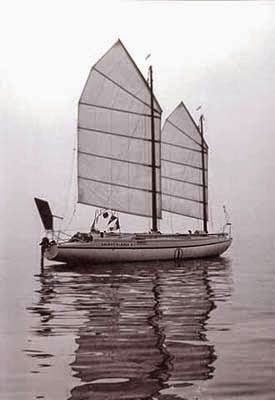 Bill King’s purpose-designed Galway Blazer circumnavigated the world solo south of the great Capes in 1973.
Bill King’s purpose-designed Galway Blazer circumnavigated the world solo south of the great Capes in 1973.
Since then, other Irish sailors who have striven to circumnavigate include Declan Mackell, originally from Portaferry but Canadian-based by the time he undertook his voyage in a Contessa 32, with which he returned home to Ireland for a prolonged stay during his circuit.
Another lone circumnavigator, Pat Lawless of Limerick who completed his voyage with a Seadog ketch in 1996 at the age of 70, had hoped to take in Cape Horn, but rigging damage forced him into a Chilean port, and eventually he returned to Ireland via the Panama Canal. But his circuit was definitely completed, and completed alone.
And Pete Hogan believes there may be one or two other Irish lone circumnavigators who have done it without fanfare. For not everyone seeks the kind of publicity which the Vendee Globe inevitably provides.
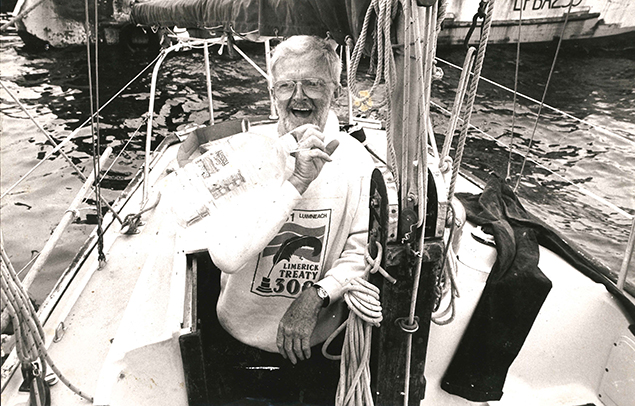 Limerick circumnavigator – the irrepressible Pat Lawless aboard his world-girdling Seadog ketch
Limerick circumnavigator – the irrepressible Pat Lawless aboard his world-girdling Seadog ketch
British sailor Alex Thomson – with Cork Harbour connections – today smashed the world record for the greatest distance sailed solo in 24 hours notching up 536.8 miles on his 60ft racing yacht.
Thomson, 42, is currently in second place in the Vendee Globe just 70 miles behind French race leader Armel Le Cleac'h with 1,000 miles to go to the finish line.
During the 24-hour period running up to the 0800 UTC position report he sailed his racing boat Hugo Boss at an average speed of 22.4 knots, or 25.7mph.
His 24-hour distance beats the record of 534.48 miles set by French sailor Francois Gabart in the 2012-13 edition of the Vendee Globe, a singlehanded race around the world without stopping.
Thomson was among a fleet of 29 mostly French solo sailors that set off from Les Sables d'Olonne in the Vendee region of France on November 6.
He actually bested Gabart's record two weeks into the race, sailing 535.34 miles in 24 hours, but the rules of the record state it must be superseded by one whole mile.
He previously held the record between 2003 and 2012 with a distance of 468.72 miles. The new record will now be ratified by the World Sailing Speed Record Council.
Thomson is expected to arrive in Les Sables d'Olonne on Thursday after 74 days at sea. The fastest time the race has ever been completed was 78 days, set by Gabart in 2013.
If Thomson, from Hampshire in England, can overhaul Le Cleac'h before the finish line he will be the first Brit to win the race in its 27-year history.
It is the fourth time he has competed in the quadrennial Vendee Globe, which is considered among the toughest sporting challenges in the world. He finished third in the previous edition.
Vendee Globe Leaders Sprint to the Finish
The race to the Vendée Globe finish line today became an all-out, neck-and-neck sprint as the leading pair's speedos rocketed into the 20s.
After several days of slow progress north in light winds, Armel Le Cléac'h and Alex Thomson (with Irish connections) were today blasting towards the home straight of the solo round the world race in winds of up to 30 knots.
The skippers, split by just 95 nautical miles, were eating up the 1,300nm standing between them and the finish line in Les Sables d'Olonne, France, as they try to squeeze every last bit of speed from their foiling IMOCA 60 raceboats.
At the 1400 UTC position update British skipper Thomson, who led the race through most of its early stages, had a narrow speed advantage as he hurtled north on Hugo Boss at 24 knots. French skipper Le Cléac'h, who has topped the rankings since December 2, was more than two knots slower as he closed in on the Azores. With the ETA in Les Sables currently Thursday, the Vendée Globe is shaping up to go right down to the wire.
“We have 17 to 20 knots of breeze at the moment and not very nice seas to be honest with the waves coming in from the east,” Thomson told Vendée Globe HQ in Les Sables today. “It's difficult to go fast but I'm not complaining because I am making good speed. It's going to get windy in the next 24 hours, up to 30 knots. We'll be going fast, and we'll have to see how things pan out.”
Thomson is competing in the Vendée Globe for the fourth time and is aiming to become the first Briton ever to win the race in its 27-year history. If he can continue to eat into Le Cléac'h's lead there is a chance he could realise his goal. Le Cléac'h, meanwhile, is hell-bent on ensuring he scores his first ever Vendée Globe win after posting runner's-up finishes in the past two editions.
The anticyclone currently blocking the duo's path to Les Sables is moving towards the English Channel and in another 36 hours the pair will be able to point their bows towards the finish line for an upwind drag race to glory.
Some 6,000nm behind the leaders the quartet of Fabrice Amedeo, Arnaud Boissières, Alan Roura and Rich Wilson from 11th to 14th were fighting a battle against Mother Nature as they approached Cape Horn, the southernmost tip of South America. North-westerly breeze of up to 40 knots was making for a testing passage past the legendary milestone, not only battering the boats but whipping up seas of up to six metres high.
Amedeo, a sports journalist-turned-solo sailor, said his primary focus was to preserve man and boat in order to keep his dream alive of finishing the Vendée Globe. “It's an amazing moment for me because it's my first rounding of Cape Horn, and it comes after one month in the south,” he said. “But because of the wind I feel a little bit stressed and it hasn't quite sunk in that I will round Cape Horn in a few hours. I'm very concentrated now but I will feel better in two days – then it will feel like a victory. I'll have a lot of wind today and tomorrow so my psychological Cape Horn will be tomorrow evening.”
The enormity of the task at hand is not lost on Swiss sailor Alan Roura, who at 23 is the race's youngest skipper. “It's my first Cape Horn and it's no holiday that's for sure,” he said. “It'll be a big, big relief to round it as it's a key passage and marks our return home. I hope we'll have milder conditions in the Atlantic.”
Replacement Mast Gets Enda O’Coineen One Step Closer To Record Books
#VendéeGlobe - Just days after admitting his “dream is shattered” after his dismasting off New Zealand at the halfway mark of the Vendée Globe, Irish skipper Enda O’Coineen is already preparing for a return to the water.
And as the Otago Daily Times reports, that’s all thanks to the kindness of Dunedin local Blair McNab, a plumber and yachtsman who read about the 61-year-old sailor’s plight and donated him a spare 9m mast.
Though smaller than his original rig, O’Coineen said it should be enough to get him to Auckland, where a replacement mast up to the task of the round-the-world offshore challenge might be sourced.
That would enable the first-time Vendée entrant to complete the route and sail Kilcullen Voyager back to Ireland, even if he’s no longer in official race contention.
"I’m the first Irishman to sail single-handedly halfway around the world — I’ve just got to do the other half,” he said.
The Otago Daily Times has more on the story HERE.
Ireland & Cork Sailing On A High As Vendee Globe Hits World Target
Enda O’Coineen may have exited the Vendee Globe in dramatic fashion on New Year’s Day when, as he drolly put it, Kilcullen Voyager stopped stone dead as she zapped into the back of a Southern Ocean wave, but his enormous mast just continued straight on with an almighty crash as it broke off clean at the deck. But this ruthless race continues on its way, and there’s still much of very specific Irish interest in it as the leaders approach the finish. W M Nixon gives us his own take on it all, and then tells us a tale out of school about Irish involvement.
It has to be the oddest geography lesson ever provided. And it has to be the most unexpectedly energetic way of promoting a relatively unknown region of France which was formerly almost exclusively associated with a relaxed way of life.
Once upon a time, the Vendee was a place which you’d usually associate with the gentler things in life. Things like good food and summer wine enjoyed in a sleepy siesta lifestyle in gently dusty villages inland from some fine beaches, villages where life moves slowly under the kindly shade of many trees, in a latitude which is not so far south as to be overly hot in summer, yet not far enough north to experience harsh winters.
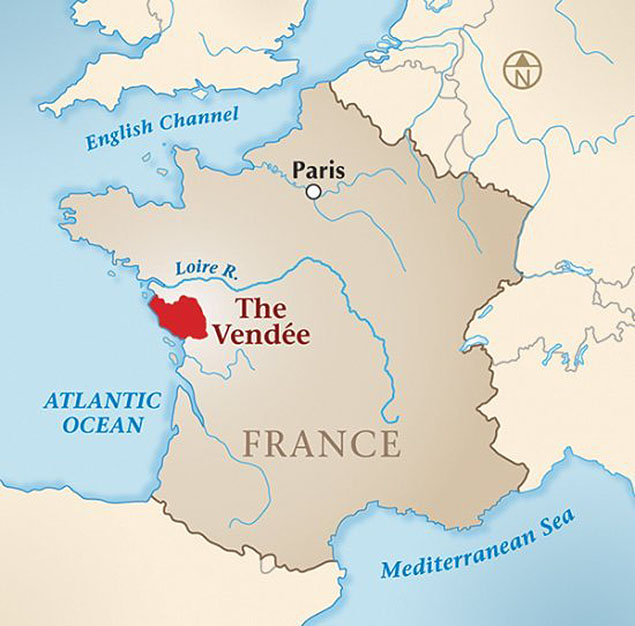 Little place that thinks big – France’s Vendee region has put itself firmly on the world map by sponsoring the Vendee Globe
Little place that thinks big – France’s Vendee region has put itself firmly on the world map by sponsoring the Vendee Globe
It’s about the size of an average Irish county. Yet right now, France’s modestly endowed Vendee region is being promoted as a place of world significance by extreme sportsmen taking part in a rugged sailing exercise with the most severe physical and life-threatening challenges, subsisting on a meagre diet which would rightly produce rioting in any self-respecting prison.
Welcome to the world of the Vendee Globe. That is, in the unlikely event that you aren’t already addicted to following it on a daily or indeed hourly basis. This still almost unbelievable round the world non-stop marathon continues to have an air of crazy novelty and enduring fascination, even though it was first staged in 1989.
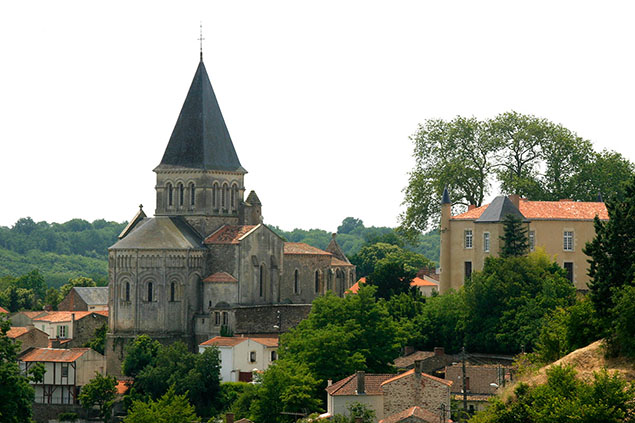 Peaceful countryside. Deep in the heart of the Vendee, the sea seems far away
Peaceful countryside. Deep in the heart of the Vendee, the sea seems far away
It boggles the mind to try and imagine the great French sailor Philippe Jeantot taking on the challenge of persuading the civil servants and politicians who run this relatively remote region of west France to permit, let alone sponsor, an event which is now utterly out on its own. Yet the regions of France quite rightly have an intense local pride. And if we in Ireland feel a tinge of envy at what they can achieve, just remember that last weekend it was announced that Wicklow Sailing Club had become the Mitsubishi Motors Club of the Year for 2017 thanks to their utter commitment to promoting the Round Ireland Race on a biennial basis, while at the same time continuing to function successfully as a club which caters for local sailing needs.
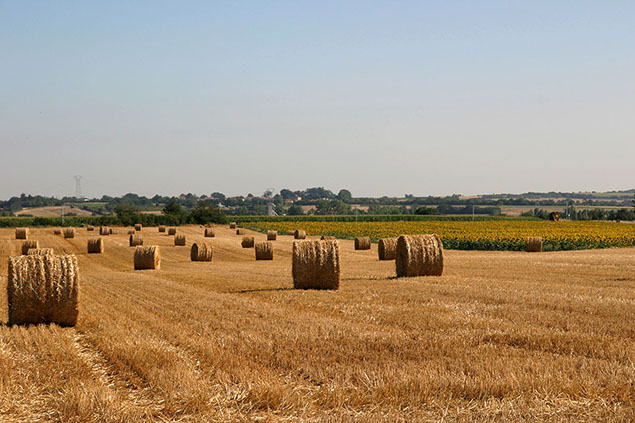 A summer cornfield in the Vendee is about as different as you can get…
A summer cornfield in the Vendee is about as different as you can get…
 ….from rounding Cape Horn in a rising gale. Yet both are linked through the world’s most challenging race
….from rounding Cape Horn in a rising gale. Yet both are linked through the world’s most challenging race
It’s something which is unusual in an overly-centralized country like Ireland, where all major decision are made in the capital, and in sailing you’d expect one of the main centres such as Cork Harbour or Dublin Bay or Belfast Lough to be the home of the Round Ireland race. But it is dogged little Wicklow which has won through, and 2016’s race fully justified their faith.
However, in the Irish context it is a local sailing club which is setting the pace. But in France, it is the regional administration which has been persuaded to pull off a remarkable coup. Looking at the scale and publicity which accompanies the Globe race, you’d assume it starts and finishes in a major centre such as Brest, or Lorient, or La Rochelle. Au contraire. The Vendee Globe starts and finishes in the very artificial sand-surrounded port of les Sables d’Olonne, set on a long sandy coast off which just about the only object of interest is the intriguing little Biscay island of Ile d’Yeu.
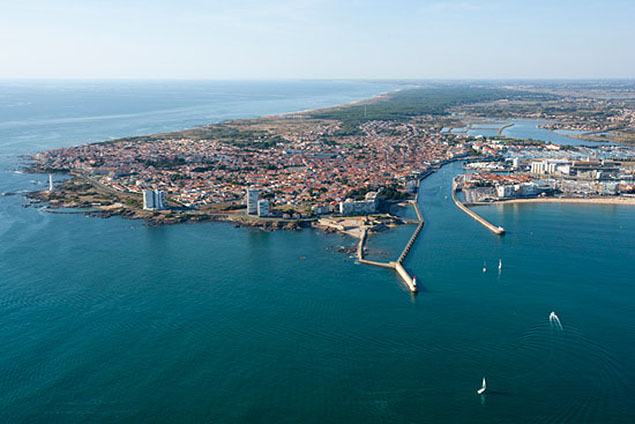 Les Sables d’Olonne, where the harbour is tucked in behind what used to be sand dunes
Les Sables d’Olonne, where the harbour is tucked in behind what used to be sand dunes
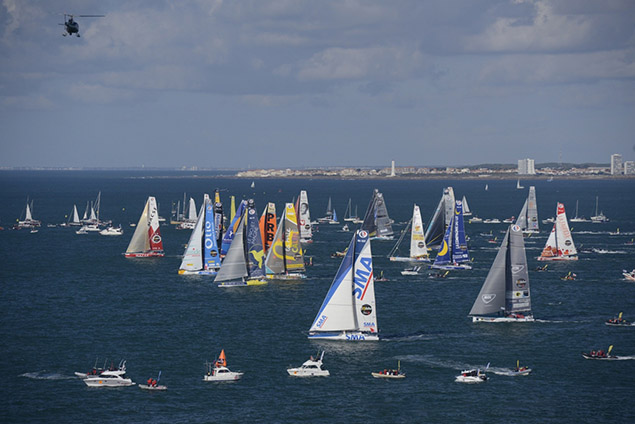 The start of the Vendee Globe 2016-2017
The start of the Vendee Globe 2016-2017
Yet despite the paucity of features of special interest along its sandy beaches, every three to four years sees Les Sables d’Olonne being swamped by hundreds of thousands of visitors when the Vendee Globe circus is in town. And this weekend, the focus sees the Race Headquarters move from their race-time base at the foot of the Eiffel Tower in Paris back to the quayside at Les Sables in anticipation of the finish, some time in the middle of next week, of the two fleet leaders.
Yesterday, gales on the Biscay coast prevented the re-installation of the super-tented Vendee Globe Village in Les Sables. But by today the command control should be broadcasting again on all media, and we can resume our daily doses of a fascinating event which is reaching its most crucial stage in an unexpected way.
For after a week in which severe storms have been sweeping most of Europe, a great big high pressure area is showing every sign of settling in over the southwest approaches to the Bay of Biscay right across the track which the two leaders – Armel le Cleac’h on Bank Populaire VIII and Alex Thompson closing up from 130 miles astern on Hugo Boss – will have to take to get to Les Sables.
C’est ridicule! The seas off northwest Spain - Galicia, Finisterre, whatever you want to call it – should be one of the stormiest places in the world in the latter half of January. Yet here it is, in an increasingly benign mood, with the final stages of the world’s breeziest race threatening to become a battle of the zephyrs.
 Enda O'Coineen and Stewart Hosford in Cork Harbour in 2015
Enda O'Coineen and Stewart Hosford in Cork Harbour in 2015
Under time-honoured traditional yacht racing tactics, all Le Cleac’h need to do is keep re-positioning himself so that he is directly between Thomson and the finish line. But these are not traditional yachts. Even in a zephyr, they can virtually create their own wind, and if the leader really does become so completely and utterly becalmed that he loses steerage way, the second-placed boat knows that his primary objective must be to maintain way even if it means actually heading away from the finish.
However, let’s face it, it is January, and it’s unlikely the total calm you might experience in high summer will ever settle in. That said, for le Cleac’h the situation is hugely challenging, for if there is one other skipper in the entire race who has the ability to pull off an audacious coup and snatch the lead, then it is 42-year-old Alex Thomson.
And in a sense, here in Ireland we can look on him as one of us. For five formative years of his childhood, he lived in the Crosshaven area, and his name can be found in the register of Templebreedy National School. His father Peter was a helicopter pilot on air-sea rescue duty, which meant that Alex was born in Bangor in North Wales as his father at the time was flying out of Anglesey, but then the move came to Cork airport, and the young Alex saw his first sailing off Weavers Point.
Sailing the seas of Cork at that time was young Stewart Hosford whose father Bill was one of the crew on Denis Doyle’s blue S&S designed Moonduster. Bill Hosford was also one of the consortium involved with Barry Burke in building the Ron Holland-desined Shamrrock racer-cruiser range, while for some added interest Bill and his wife Ann for ten years owned that deservedly renowned West Cork hostelry Mary Ann’s in the picturesque village of Castletownshend.
However, the challenge of life as an international banking executive drew young Stewart away from Cork, and he spent fifteen years in the City of London and another five in Edinburgh before the call of the sea returned, and he and his mates bought the Farr 65 Spirit of Diana in 2000 and linked up with the recent winning skipper in the Clipper Round the World Race, one Alex Thomson, to go racing. The rest is history.
 “Alex does the sailing and the stunts…..” A spot of keel-walking with Hugo Boss
“Alex does the sailing and the stunts…..” A spot of keel-walking with Hugo Boss
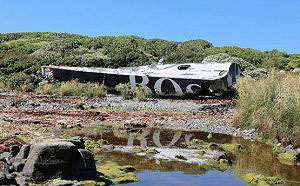 Even when things don’t go quite according to plan, somehow it still seems a success…
Even when things don’t go quite according to plan, somehow it still seems a success…
The synergy between the two men in creating a boat racing organization is extraordinary. Even though Stewart is now based back in Cork, life is totally peripatetic as he fulfills the role of CEO of Alex Thomson Racing, while Alex does the sailing and the stunts, and Sir Keith Mills is the third corner of a remarkable triangle for creating success.
The well-established link-up with Hugo Boss completed the package, and while on occasion things have gone spectacularly wrong, there’s something about an Alex Thomson Racing failure which makes it into a success. The man himself has a superhuman dedication and determination, and an ability to think completely outside the box, which makes their involvement in any event add greatly to its success.
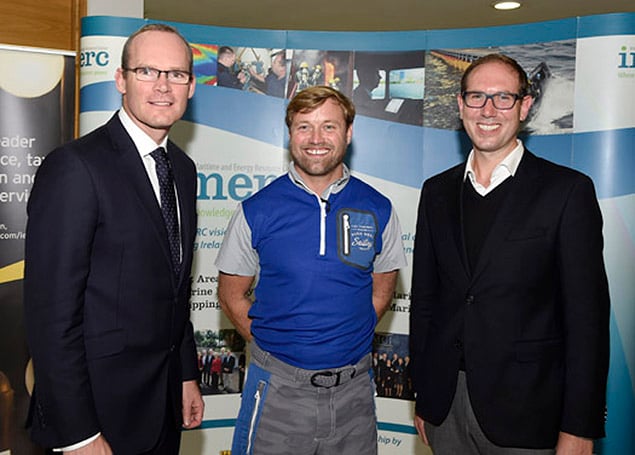 The then Minister for the Marine Simon Coveney with Alex Thomson and Stewart Hosford at a press briefing to put forward some proposals for developments on Cork Harbour
The then Minister for the Marine Simon Coveney with Alex Thomson and Stewart Hosford at a press briefing to put forward some proposals for developments on Cork Harbour
Most of us have lost count of how many different boats called Hugo Boss there have actually been, but there’s no doubt the current boat – after some setbacks which would have rebuffed a lesser squad – has evolved into on of the most formidable racing machines on the planet.
So even though it’s unlikely she’ll get starboard tack all the rest of the way to the finish in order for her lack of a starboard foil not to be a disadvantage, Hugo Boss racing has now reached such a level of attention that any outcome is ultra-newsworthy.
But though we talk of the Alex Thomson Racing challenges having reached a certain kevel, staying level is that last thing on the minds of these guys. They’ve all sorts of other ideas taking shape, and their track record is such that if they were so inclined, they could make a tidy living as consultants to nascent challenge projects. That is most unlikely. They’ve moved on a long way from Templebreedy. But even so, it still means a lot to Alex Thomson and Stewart Hosford when the latest Hugo Boss puts in an appearance at Crosshaven.
 Enda O’Coineen’s Kilcullen Voyager and the previous Hugo Boss off Crosshaven, where Alex Thomson spent five years of his childhood.
Enda O’Coineen’s Kilcullen Voyager and the previous Hugo Boss off Crosshaven, where Alex Thomson spent five years of his childhood.
Vendee Globe Leaders Compress in Race to Les Sables
Friday the 13th might be unlucky for some, but not for British skipper Alex Thomson who has pulled back 85 crucial miles on Vendée Globe leader Armel Le Cléac'h in the last 24 hours.
Thomson revealed yesterday that in order to stand a chance of overhauling French skipper Le Cléac'h before the finish of the solo round the world race he must get to within 50 miles of him in the next few days. At the 1400 UTC position report yesterday Thomson's Hugo Boss was 216 miles adrift of Le Cléac'h's Banque Populaire VIII as the pair passed to the west of the Cape Verde Islands. At the same time today that deficit was down to 131 miles as light winds forced Le Cléac'h to slow to just one knot compared to Thomson's eight knots. Thomson too will see speeds drop as he hits the dead spot but with several days of light-wind sailing ahead before stronger south-easterlies fill in near the Azores even the smallest of gains were welcome.
Thomson was not the only one with reason to celebrate. Crossing the Equator yesterday 13 days, three hours and 59 minutes after rounding Cape Horn, Jean-Pierre Dick set a new race record for the passage. Incredibly he shaved almost 16 hours off the reference time of Vendée 2012-13 winner François Gabart of 13 days, 19 hours and 29 minutes. In fact, Dick was just the first of four skippers to beat Gabart's time. Thomson posted a time of 13 days, five hours and 30 minutes, Yann Eliès took 13 days, seven hours and 20 minutes while Jean Le Cam was just 37 minutes behind. In stark comparison, race leader le Cléac'h was almost 32 hours slower than Dick over the same distance, but his woes did not stop there. His losses caused by a painful crossing of the Doldrums were today laid bare. Fifteen of the race's remaining 18 skippers made gains on Banque Populaire over the past seven days. Frenchman Eric Bellion has been by far the biggest winner in the last week, pulling back 641nm on Le Cléac'h, with Jean-Pierre Dick was next in line making back 388nm. Only Thomson and 17th-placed Pieter Heerema lost ground on Le Cléac'h, Thomson dropping 26nm to the leader and Heerema losing 10nm.
The Vendée Globe finish line is now within 1,800 miles of Le Cléac'h, and his ETA in Les Sables remains Thursday January 19th. Race HQ has now moved from Paris and is set up in Les Sables ready for the opening of the race village tomorrow. Doors to the village, at Port Olona, open to the public at 10am local time and visitors can enjoy an exhibition on the race, shop for official Vendée Globe merchandise or relax in the race's legendary bar and restaurant, the VOG. A huge screen will show the arrivals live from the finish line to the pontoon, and skippers will then be interviewed on the main stage.


























